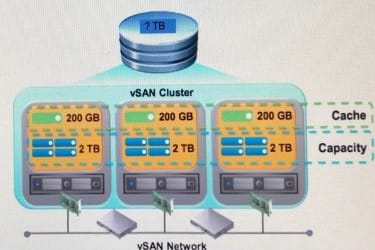2VB-601 Online Practice Questions and Answers
What are two main advantages of using multiple disk groups within each host? (Choose two.)
A. Performance
B. Backward compatibility
C. Cost
D. Redundancy
What are three fundamental concepts of vSAN clusters? (Choose three.)
A. Flash devices can be shared between disk groups.
B. A maximum of seven capacity disks per disk group is supported.
C. A maximum of five disk groups per host is supported.
D. Dual socket CPU for each host is required.
E. Once cache drive per disk group is required.
When implementing vSAN stretched clusters, bandwidth requirements between the preferred and secondary sites are determined by which factors?
A. Total number of read operations and block size
B. Total number of components and block size
C. Total number of write operations and block size
D. Total number of read operations, total number of write operations and block size
Which three of the listed objects types can be viewed in the vSAN Used Capacity Breakdown user interface? (Choose three.)
A. Swap objects
B. Disk groups
C. File system overhead
D. Virtual disks
E. Physical disks
Storage policies can be based on which two types of rules? (Choose two.)
A. Data services provided by hosts.
B. Datastore placement provided by Storage DRS.
C. Data services provided by datastores.
D. Data services provided by virtual machines.
Which three objects that belong to virtual machines are contained in a vSAN datastore? (Choose three.)
A. VM Health Status
B. VMDK
C. VM Home Namespace
D. Performance Statistics
E. VM Swap
An administrator is designing a vSAN cluster for a number of new workloads. The design calls for the use of erasure coding with RAID 5.
Which statement is true about what is needed to meet the needs of this scenario?
A. vSAN Standard licensing is sufficient
B. vSAN Enterprise licensing is required
C. An all-flash configuration is required.
D. Six nodes are required at a minimum.
Exhibit:

View the exhibit.
The following are configuration details for a three-node all-flash vSAN cluster
1.
Each node is identical in number of drives and disk controllers
2.
Each node has 4 x 500 GB SSD Capacity Tier, 1 x 200 GB SSD cache tier
What is the raw capacity of this cluster as configured?
A. 6.6 TB
B. 3 TB
C. 6 TB
D. 4 TB
Which two factors below determine how a VMDK object will be split on a vSAN cluster? (Choose two.)
A. Checksum parameter
B. Free capacity in the cache tier devices
C. Size of the VMDK object
D. Stripe width parameter
Which statement is true about vSAN three-node cluster configuration?
A. Three-node clusters can tolerate a maximum of 2 host failures as long as there are at least 2 disk groups in each host.
B. A storage policy with a RAID-5/6 erasure coding rule cannot be applied to a virtual machine object.
C. A storage policy with a deduplication and compression rule can be applied to a virtual machine object.
D. Three-node clusters can tolerate a maximum of 2 host failures.
Which storage policy is automatically created by Horizon View?
A. Level of failures to tolerate
B. Checksum
C. Horizon Default Storage Policy
D. Linked Clone
What is the purpose of the cache tier in an all-flash vSAN configuration?
A. The cache tier is used only for write buffering.
B. The cache tier is used only for read cache.
C. 70% of the cache tier is used for read cache and 30% is used for write buffering.
D. 50% of the cache tier is used for read cache and 50% is used for write buffering.
vSAN supports Microsoft Windows Server Failover Cluster (WSFC) with which configuration?
A. File share witness quorum with Exchange Database Availability Groups, SQL Server AlwaysON Availability Groups (AAG)
B. Virtual raw device mapping (RDM) with Exchange Database Availability Groups, SQL Server AlwaysOn Availability Groups (AAG)
C. FCI witness quorum with Exchange Database Availability Groups, SQL Server AlwaysOn Availability Groups (AAG)
D. NFS mount witness quorum with Exchange Database Availability Groups, SQL Server AlwaysON Availability Groups (AAG)
In order to support Oracle Real Application Cluster (RAC), which change must be made to each applicable virtual machine?
A. Set virtual disk sharing to multiwrite mode.
B. Enable vApp options.
C. Change SCSI controller type from virtual to physical.
D. Enable virtual machine Memory Hot Plug.
Which two requirements must be satisfied for a v object protected by a RAID-1 mirroring policy to be accessible? (Choose two.)
A. Primary level of failures to tolerate is set to 1 or higher.
B. More than 50% of the object's votes must be available.
C. Every component must have at least two votes.
D. At least one full replica of the object must be available.
E. vSphere HA must be enabled.
